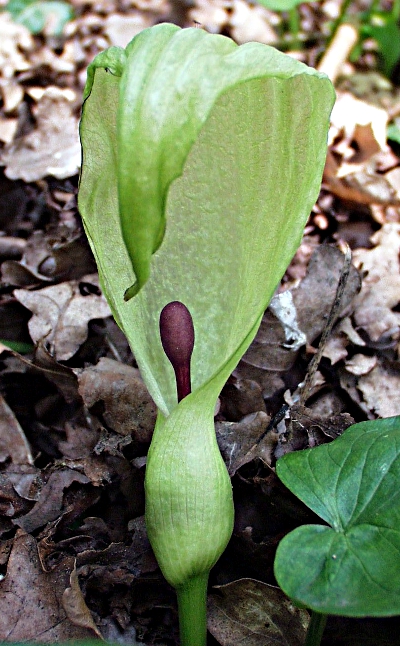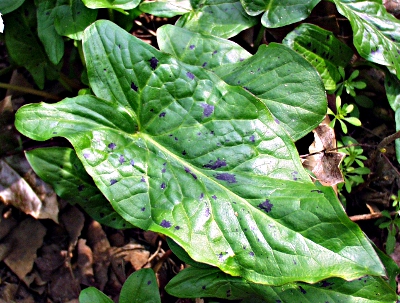Cuckoo-pint, lords-and-ladies |



Habit, fruits and leaf of the cuckoo-pint
| Arum maculatum L.: | |
| Blooming period: | April–May |
| Height: | 20–40 cm |
| Flowers: | unisexual, ♂: stamens: 3–4, fused to a synandrium, ♀: superior ovary with a sessile scar |
| Petals: | missing |
| Leaves: | basal, mostly 2, broadly arrow-like |
Plants perennial, herbaceous, with up to 2.5 cm thick, bulbous, brown rhizome.
Leaves 2–3, petioles about 20 cm long, broadly hastate to arrow-shaped, shiny, dark green, sometimes mottled dark brown.
Stem
erect, round, smooth, glabrous, unbranched, 10–14 cm long.
On
the scape there is a spadix on
which the sessile flowers are
arranged
in rings. The lower ones are female and consist exclusively of a
pistil. Above them there are a few of sterile, female flowers which are
reduced to bristles.
The 3rd ring contains fertile, male flowers, which consist only of 3–4 stamens fused to a synandrium. Above them there are sterile male flowers with only one reduced stamen, also known as weir basket hairs. The upper part of the spadix (appendix) is club-shaped and flowerless.
The spadix is surrounded by a cone-shaped, yellow-green bract, the spathe, which is longer than the spadix. It is rolled at the base into a tube that surrounds the flowers. In the upper part the spathe is spread out and terminates at the top in a point. This part can be up to 6 times longer than the tube. Between tube and lamina, in the area of the ring of hairs, there is a narrowing.
After pollination by carrion flies or sandflies the lower flowers form round to oval, red, crowded, 1- to 3-seeded berries. At the fruit time appendix and spathe missing. Plants poisonous in all parts!
| Floral formula: |
| ♂ * P0 (A3–4) G0 ♀ * P0 A0 (G1+2°) |
Occurrence:
Moist
deciduous forests, bushes, gardens. Prefers shady, slightly warm,
moist, slightly calcareous, very nitrogenous locations.
Distribution:
Europe,
West Asia and North Africa.